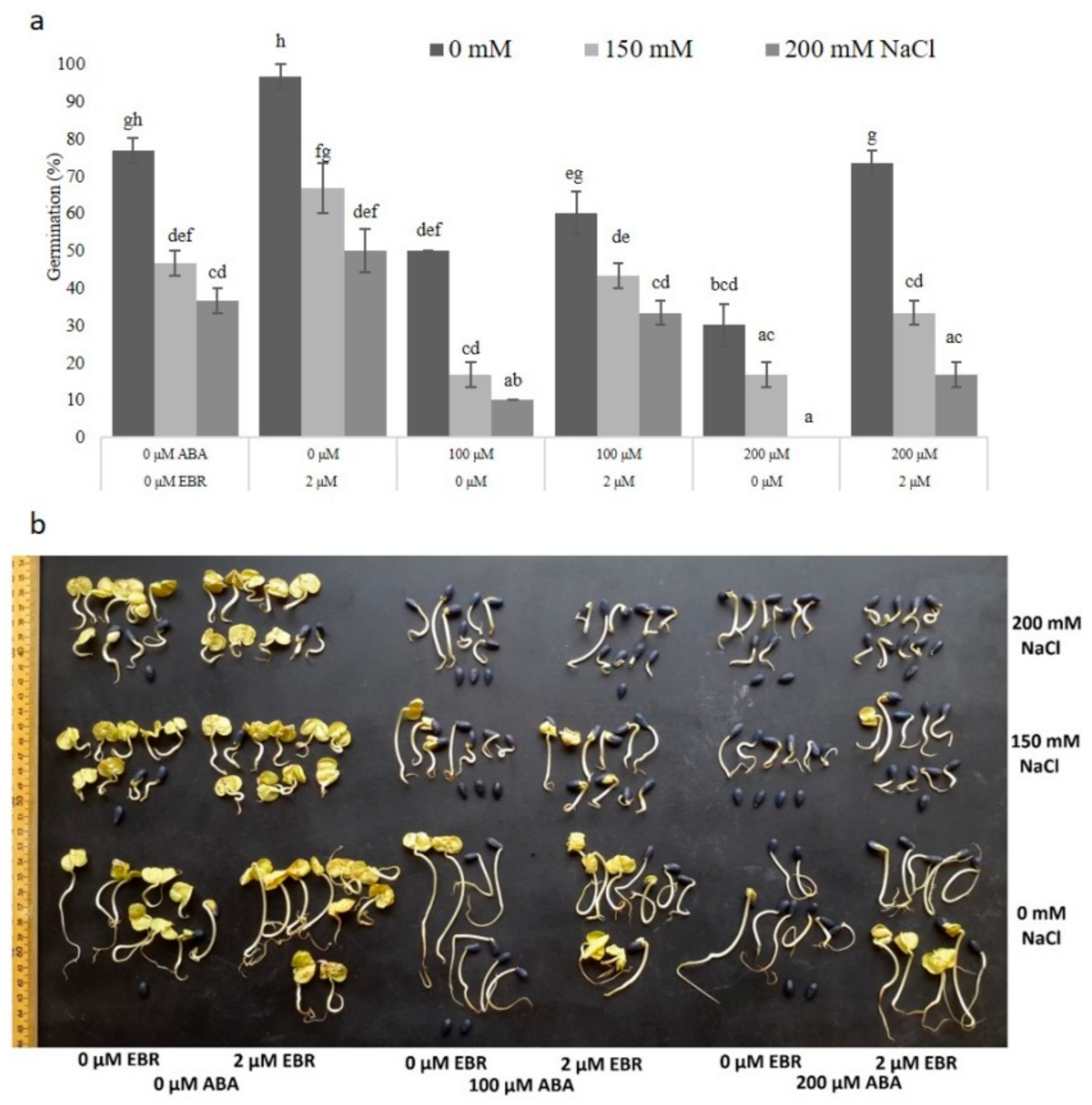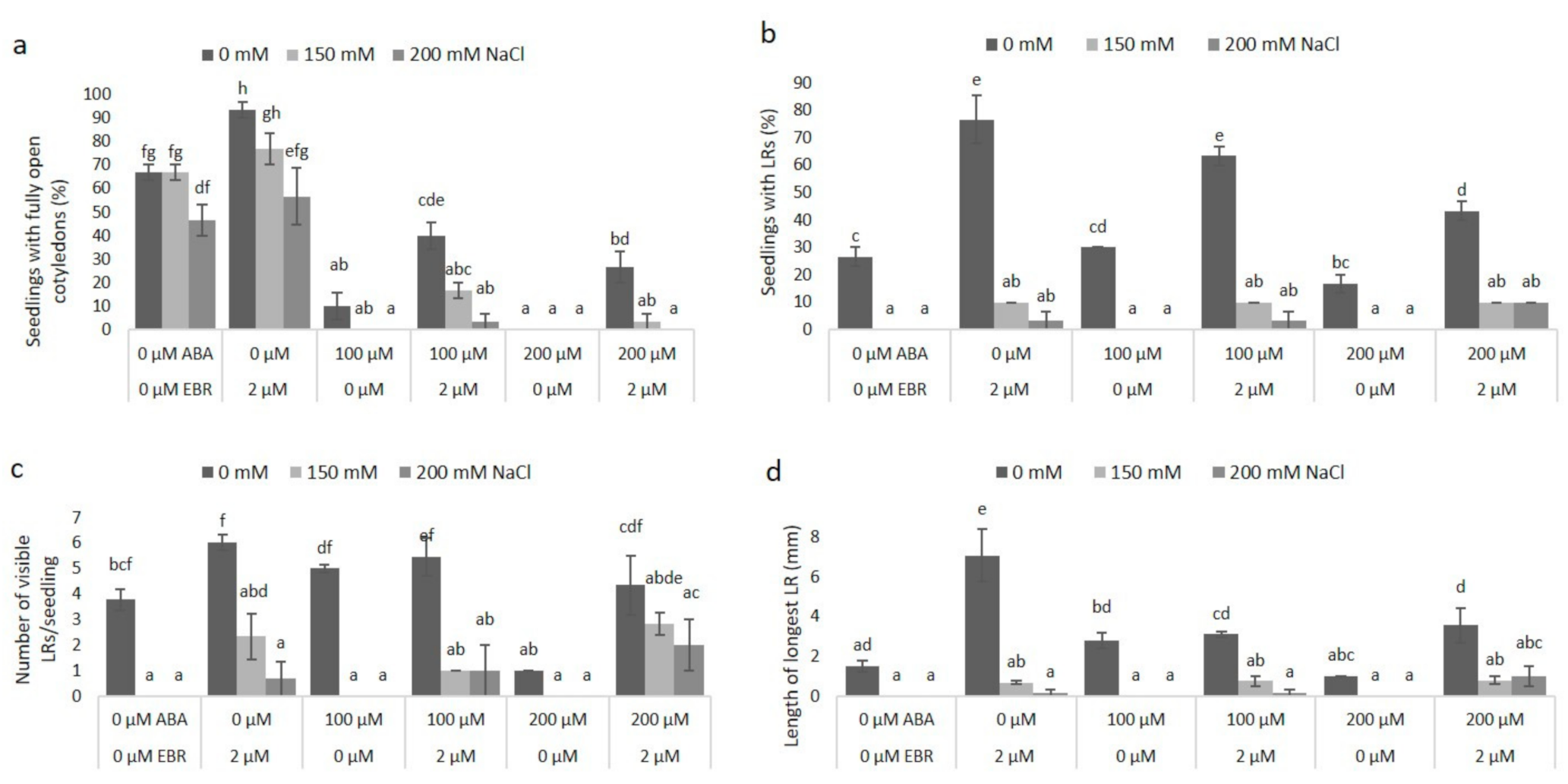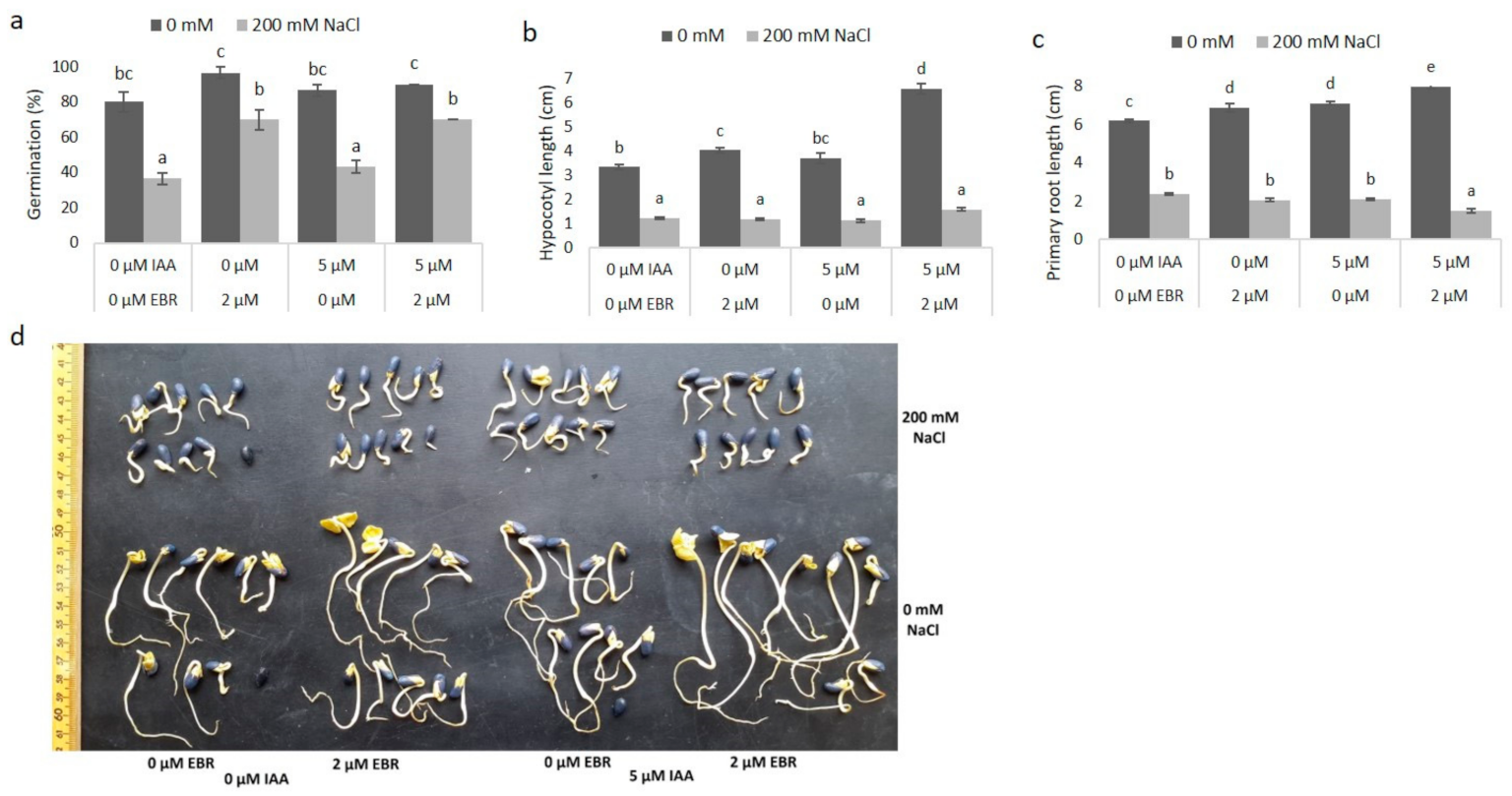Cotton Seed Priming with Brassinosteroid Promotes Germination and Seedling Growth
Abstract
:1. Introduction
2. Materials and Methods
2.1. Plant Material
2.2. Hormone Preparation and Seed Treatment
2.3. Germination and Seedling Growth under Heat Stress (HS) and Salt Stress
2.4. Statistical Analyses
3. Results
3.1. Effect of 24-Epibrassinolide (EBR) on Cotton Seed Germination and Seedling Growth under Salinity Stress
3.2. Combined Effect of EBR and Abscisic Acid (ABA), Indole-3-Acetic Acid (IAA) or Gibberellin (GA) on Germination and Seedling Growth under Salinity Stress
3.3. Effect of EBR on Seed Germination and Seedling Growth under Heat Stress
4. Discussion
Author Contributions
Funding
Acknowledgments
Conflicts of Interest
References
- Australian Cotton. Available online: https://cottonaustralia.com.au (accessed on 1 December 2020).
- OECD; FAO. Agricultural Outlook 2020–2029. In OECD Agriculture Statistics; OECD/FAO: Rome, Italy.
- Pettigrew, W.T. The Effect of Higher Temperatures on Cotton Lint Yield Production and Fiber Quality. Crop. Sci. 2008, 48, 278–285. [Google Scholar] [CrossRef] [Green Version]
- Zahid, K.R.; Ali, F.; Shah, F.; Younas, M.; Shah, T.; Shahwar, D.; Hassan, W.; Ahmad, Z.; Qi, C.; Lu, Y.; et al. Response and Tolerance Mechanism of Cotton Gossypium hirsutum L. to Elevated Temperature Stress: A Review. Front. Plant Sci. 2016, 7, 937. [Google Scholar] [CrossRef] [PubMed] [Green Version]
- Reddy, K.R.; Hodges, H.F. Temperature Effects on Early Season Cotton Growth and Development. Agron. J. 1992, 84, 229–237. [Google Scholar] [CrossRef]
- Reddy, K.R.; Hodges, H.F.; McKinion, J.M.; Wall, G.W. Temperature Effects on Pima Cotton Growth and Development. Agron. J. 1992, 84, 237–243. [Google Scholar] [CrossRef]
- Bibi, A.C.; Oosterhuis, D.M.; Gonias, E.D. Photosynthesis, quantum yield of photosystem II and membrane leakage as affected by high temperatures in cotton genotypes. J. Cotton Sci. 2008, 12, 150–159. [Google Scholar]
- Nachshon, U. Cropland soil salinization and associated hydrology: Trends, processes and examples. Water 2018, 10, 1030. [Google Scholar]
- Sharif, I.; Aleem, S.; Farooq, J.; Rizwan, M.; Younas, A.; Sarwar, G.; Chohan, S.M. Salinity stress in cotton: Effects, mechanism of tolerance and its management strategies. Physiol. Mol. Biol. Plants 2019, 25, 807–820. [Google Scholar] [CrossRef] [PubMed]
- Khorsandi, F.; Anagholi, A. Reproductive Compensation of Cotton after Salt Stress Relief at Different Growth Stages. J. Agron. Crop. Sci. 2009, 195, 278–283. [Google Scholar] [CrossRef]
- Greenway, H.; Munns, R. Mechanisms of salt tolerance in non-halophytes. Annu. Rev. Plant Physiol. Plant Mol. Biol. 1980, 31, 149–190. [Google Scholar] [CrossRef]
- Dong, H. Combating salinity stress effects on cotton with agronomic practices. Afr. J. Agric. Res. 2012, 7, 4708–4715. [Google Scholar] [CrossRef]
- Chen, L.; Liu, L.; Lu, B.; Ma, T.; Jiang, D.; Li, J.; Zhang, K.; Sun, H.; Zhang, Y.; Bai, Z.; et al. Exogenous melatonin promotes seed germination and osmotic regulation under salt stress in cotton (Gossypium hirsutum L.). PLoS ONE 2020, 15, e0228241. [Google Scholar] [CrossRef] [PubMed] [Green Version]
- Rhaman, M.S.; Rauf, F.; Tania, S.S.; Khatun, M. Seed Priming Methods: Application in Field Crops and Future Perspectives. Asian J. Res. Crop. Sci. 2020, 5, 8–19. [Google Scholar] [CrossRef]
- Gour, L.; Ramakrishnan, R.S.; Panwar, N.K.; Sharma, R.; Pathak, N.; Koutu, G.K. Seed Priming: An old empirical technique with new contemporary perspectives in respect to Pisum sativum L: A review. Agric. Rev. 2019, 40, 136–142. [Google Scholar] [CrossRef] [Green Version]
- Rhaman, M.S.; Imran, S.; Rauf, F.; Khatun, M.; Baskin, C.C.; Murata, Y.; Hasanuzzaman, M. Seed Priming with Phytohormones: An Effective Approach for the Mitigation of Abiotic Stress. Plants 2020, 10, 37. [Google Scholar] [CrossRef]
- Krishna, P. Brassinosteroid-Mediated Stress Responses. J. Plant Growth Regul. 2003, 22, 289–297. [Google Scholar] [CrossRef]
- Divi, U.K.; Krishna, P. Brassinosteroids Confer Stress Tolerance. In Plant Stress Biology; Wiley: Hoboken, NJ, USA, 2010; pp. 119–135. [Google Scholar]
- Jiang, W.-B.; Lin, W.-H. Brassinosteroid functions in Arabidopsis seed development. Plant Signal. Behav. 2013, 8, e25928. [Google Scholar] [CrossRef] [Green Version]
- Steber, C.M.; McCourt, P. A Role for Brassinosteroids in Germination in Arabidopsis. Plant Physiol. 2001, 125, 763–769. [Google Scholar] [CrossRef] [PubMed] [Green Version]
- Divi, U.K.; Krishna, P. Overexpression of the Brassinosteroid Biosynthetic Gene AtDWF4 in Arabidopsis Seeds Overcomes Abscisic Acid-induced Inhibition of Germination and Increases Cold Tolerance in Transgenic Seedlings. J. Plant Growth Regul. 2010, 29, 385–393. [Google Scholar] [CrossRef]
- Kagale, S.; Divi, U.K.; Krochko, J.E.; Keller, W.A.; Krishna, P. Brassinosteroid confers tolerance in Arabidopsis thaliana and Brassica napus to a range of abiotic stresses. Planta 2006, 225, 353–364. [Google Scholar] [CrossRef]
- Li, Q.-F.; Xiong, M.; Xu, P.; Huang, L.; Zhang, C.-Q.; Liu, Q.-Q. Dissection of brassinosteroid-regulated proteins in rice embryos during germination by quantitative proteomics. Sci. Rep. 2016, 6, 34583. [Google Scholar] [CrossRef] [Green Version]
- Dhaubhadel, S.; Browning, K.S.; Gallie, D.R.; Krishna, P. Brassinosteroid functions to protect the translational machinery and heat-shock protein synthesis following thermal stress. Plant J. 2002, 29, 681–691. [Google Scholar] [CrossRef] [PubMed]
- Divi, U.K.; Rahman, T.; Krishna, P. Gene expression and functional analyses in brassinosteroid-mediated stress tolerance. Plant Biotechnol. J. 2015, 14, 419–432. [Google Scholar] [CrossRef] [PubMed] [Green Version]
- Sun, Y.; Veerabomma, S.; Abdel-Mageed, H.A.; Fokar, M.; Asami, T.; Yoshida, S.; Allen, R.D. Brassinosteroid Regulates Fiber Development on Cultured Cotton Ovules. Plant Cell Physiol. 2005, 46, 1384–1391. [Google Scholar] [CrossRef]
- Yang, Z.; Zhang, C.; Yang, X.; Liu, K.; Wu, Z.; Zhang, X.; Zheng, W.; Xun, Q.; Liu, C.; Lu, L.; et al. PAG1, a cotton brassinosteroid catabolism gene, modulates fiber elongation. New Phytol. 2014, 203, 437–448. [Google Scholar] [CrossRef]
- Liu, Z.; Chen, Y.; Wang, N.; Chen, Y.; Wei, N.; Lu, R.; Li, Y.; Li, X. A basic helix–loop–helix protein (GhFP1) promotes fibre elongation of cotton (Gossypium hirsutum) by modulating brassinosteroid biosynthesis and signalling. New Phytol. 2019, 225, 2439–2452. [Google Scholar] [CrossRef] [PubMed]
- Sun, Y.; Veerabomma, S.; Fokar, M.; Abidi, N.; Hequet, E.; Payton, P.; Allen, R.D. Brassinosteroid signaling affects secondary cell wall deposition in cotton fibers. Ind. Crop. Prod. 2015, 65, 334–342. [Google Scholar] [CrossRef]
- Reid, P. Sicala V-2. Plant Var. J. 1995, 8, 12–13. [Google Scholar]
- Stiller, W.; Reid, P. Sicot 730. Plant Var. J. 2013, 26, 89–92. [Google Scholar]
- R Core Team. R: A Language and Environment for Statistical Computing; R Foundation for Statistical Computing: Vienna, Austria, 2018; Available online: https://www.R-project.org (accessed on 10 October 2018).
- Garciarrubio, A.; Legaria, J.P.; Covarrubias, A.A. Abscisic acid inhibits germination of mature Arabidopsis seeds by limiting the availability of energy and nutrients. Planta 1997, 203, 182–187. [Google Scholar] [CrossRef] [PubMed]
- Humplík, J.F.; Bergougnoux, V.; Jandová, M.; Šimura, J.; Pěnčík, A.; Tomanec, O.; Rolčík, J.; Novák, O.; Fellner, M. Endogenous Abscisic Acid Promotes Hypocotyl Growth and Affects Endoreduplication during Dark-Induced Growth in Tomato (Solanum lycopersicum L.). PLoS ONE 2015, 10, e0117793. [Google Scholar] [CrossRef]
- Liu, X.; Zhang, H.; Zhao, Y.; Feng, Z.; Li, Q.; Yang, H.-Q.; Luan, S.; Li, J.; He, Z.-H. Auxin controls seed dormancy through stimulation of abscisic acid signaling by inducing ARF-mediated ABI3 activation in Arabidopsis. Proc. Natl. Acad. Sci. USA 2013, 110, 15485–15490. [Google Scholar] [CrossRef] [Green Version]
- Debeaujon, I.; Koornneef, M. Gibberellin Requirement for Arabidopsis Seed Germination Is Determined Both by Testa Characteristics and Embryonic Abscisic Acid. Plant Physiol. 2000, 122, 415–424. [Google Scholar] [CrossRef] [PubMed] [Green Version]
- Gou, J.; Strauss, S.H.; Tsai, C.J.; Fang, K.; Chen, Y.; Jiang, X.; Busov, V.B. Gibberellins regulate lateral root formation in populus through interactions with auxin and other hormones. Plant Cell 2010, 22, 623–639. [Google Scholar] [CrossRef] [PubMed] [Green Version]
- Placido, D.F.; Sandhu, J.; Sato, S.J.; Nersesian, N.; Quach, T.; Clemente, T.E.; Staswick, P.E.; Walia, H. The LATERAL ROOT DENSITY gene regulates root growth during water stress in wheat. Plant Biotechnol. J. 2020, 18, 1955–1968. [Google Scholar] [CrossRef] [PubMed] [Green Version]
- Shu, K.; Liu, X.-D.; Xie, Q.; He, Z.-H. Two Faces of One Seed: Hormonal Regulation of Dormancy and Germination. Mol. Plant 2016, 9, 34–45. [Google Scholar] [CrossRef] [Green Version]
- Julkowska, M.M.; Koevoets, I.T.; Mol, S.; Hoefsloot, H.; Feron, R.; Tester, M.A.; Keurentjes, J.J.; Korte, A.; Haring, M.A.; De Boer, G.-J.; et al. Genetic Components of Root Architecture Remodeling in Response to Salt Stress. Plant Cell 2017, 29, 3198–3213. [Google Scholar] [CrossRef] [Green Version]
- Wei, Z.; Li, J. Brassinosteroids Regulate Root Growth, Development, and Symbiosis. Mol. Plant 2016, 9, 86–100. [Google Scholar] [CrossRef] [Green Version]
- De Smet, I.; Signora, L.; Beeckman, T.; Inzé, D.; Foyer, C.H.; Zhang, H. An abscisic acid-sensitive checkpoint in lateral root development ofArabidopsis. Plant J. 2003, 33, 543–555. [Google Scholar] [CrossRef] [Green Version]
- Nemhauser, J.L.; Mockler, T.C.; Chory, J. Interdependency of Brassinosteroid and Auxin Signaling in Arabidopsis. PLoS Biol. 2004, 2, e258. [Google Scholar] [CrossRef]
- Li, Q.F.; Wang, J.D.; Xiong, M.; Wei, K.; Zhou, P.; Huang, L.-C.; Zhang, Z.-Q.; Fan, X.-L.; Liu, Q.-Q. iTRAQ-based analysis of proteins co-regulated by brassinosteroids and gibberellins in rice embryos during seed germination. Int. J. Mol. Sci. 2018, 19, 3460. [Google Scholar] [CrossRef] [PubMed] [Green Version]
- Li, Q.-F.; He, J.-X. Mechanisms of signaling crosstalk between brassinosteroids and gibberellins. Plant Signal. Behav. 2013, 8, e24686. [Google Scholar] [CrossRef] [PubMed] [Green Version]
- Singh, R.P.; Prasad, P.V.; Sunita, K.; Giri, S.; Reddy, K.R. Influence of High Temperature and Breeding for Heat Tolerance in Cotton: A Review. Adv. Agron. 2007, 93, 313–385. [Google Scholar] [CrossRef]
- Arndt, C.H. Temperature-growth relations of the roots and hypocotyls of cotton seedlings. Plant Physiol. 1945, 20, 200–220. [Google Scholar] [CrossRef] [PubMed] [Green Version]
- Khan, R.A. Effect of high-temperature stress on the growth and seed characteristics of barley and cotton. In Genetic Diversity in Plants; Basic Life Sciences, Muhammed, A., Aksel, R., von Borstel, R.C., Eds.; Springer: Boston, MA, USA, 1977; Volume 8. [Google Scholar]







Publisher’s Note: MDPI stays neutral with regard to jurisdictional claims in published maps and institutional affiliations. |
© 2021 by the authors. Licensee MDPI, Basel, Switzerland. This article is an open access article distributed under the terms and conditions of the Creative Commons Attribution (CC BY) license (http://creativecommons.org/licenses/by/4.0/).
Share and Cite
Chakma, S.P.; Chileshe, S.M.; Thomas, R.; Krishna, P. Cotton Seed Priming with Brassinosteroid Promotes Germination and Seedling Growth. Agronomy 2021, 11, 566. https://doi.org/10.3390/agronomy11030566
Chakma SP, Chileshe SM, Thomas R, Krishna P. Cotton Seed Priming with Brassinosteroid Promotes Germination and Seedling Growth. Agronomy. 2021; 11(3):566. https://doi.org/10.3390/agronomy11030566
Chicago/Turabian StyleChakma, Shyama Prashad, Stephen Mushimwa Chileshe, Richard Thomas, and Priti Krishna. 2021. "Cotton Seed Priming with Brassinosteroid Promotes Germination and Seedling Growth" Agronomy 11, no. 3: 566. https://doi.org/10.3390/agronomy11030566







